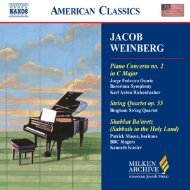Download Liner Notes PDF - Milken Archive of Jewish Music
Download Liner Notes PDF - Milken Archive of Jewish Music
Download Liner Notes PDF - Milken Archive of Jewish Music
You also want an ePaper? Increase the reach of your titles
YUMPU automatically turns print PDFs into web optimized ePapers that Google loves.
gestures and moments <strong>of</strong> classical development(augmentation, permutation, etc.) raise it to ahigher artistic level.As with the three Weinberg encore pieces recordedhere, this Hassidic Dance exhibits a fusion <strong>of</strong>Hassidic-type (but probably Ellstein’s own) melodyon traditional models with unrelated klezmerband clarinet effects and idiomatic nuances. Inaddition, even this small piece shows us a flash <strong>of</strong>Ellstein the brilliant orchestrator—as well as thepotentially classical composer.Osvaldo Golijov: ROCKETEKYARocketekya was commissioned for the twentiethanniversary <strong>of</strong> New York City’s Merkin ConcertHall. Golijov wrote it for clarinetist David Krakauer,violinist Alicia Svigals, electric violist MarthaMooke, and double bassist Pablo Aslan, whoplayed the premiere in 1998 and are also heard inthe present recording. The composer has writtenthe following remarks about the piece:I was asked to write a celebratory fanfare. Butthen I thought it would be interesting to writea different sort <strong>of</strong> celebratory piece, and I hadan idea: a sh<strong>of</strong>ar blasting inside a rocket—anancient sound propelled towards the future.So, that is Rocketekya: a sh<strong>of</strong>ar blasting itst’ki’a (one <strong>of</strong> its prescribed pattern calls) insidea rocket. In the middle <strong>of</strong> its journey, therocket meets a Latin band in orbit…. I wrotethe piece for four musicians I love and admire,and dedicated it to Vicki Margulies, who wasthe hall’s artistic director at the time.The use <strong>of</strong> various traditional klezmer bandclarinet inflections and timbres gives the piecean overall feeling <strong>of</strong> a fusion <strong>of</strong> some <strong>of</strong> thetypical sounds <strong>of</strong> 19th-century eastern Europeanklezmorim, contemporary Latin rhythms and flavors,and postmodern auras and sensibilities. Butdespite its futuristic impulse, the klezmer bandidioms and emblematic eastern European intervalspredominate and permeate the piece.About the Performers—Neil W. LevinClarinetist DAVID KRAKAUER, who grew up inNew York City, is a graduate <strong>of</strong> the Juilliard Schooland the Paris Conservatoire. As a member <strong>of</strong> theAspen Wind Quintet, he won the NaumburgChamber <strong>Music</strong> Award in 1984. He is now a leadingexponent <strong>of</strong> the eastern European “klezmer”idiom, as well as a major interpreter <strong>of</strong> the classicalrepertoire. He has been heard around theDavid Krakauerworld with his Klezmer Madness! ensemble, and his compositions for the group, while firmly rootedin traditional eastern European klezmer-type folk tunes, also pay homage to jazz, rock, experimentalclassical, and funk. He has appeared as guest soloist with such groups as the Tokyo String Quartet, theChamber <strong>Music</strong> Society <strong>of</strong> Lincoln Center, and the Berlin Radio Orchestra, and in collaboration withthe Kronos Quartet.Krakauer’s discography is extensive. His critically acclaimed release A New Hot One on the French jazzlabel Bleu was awarded France’s prestigious Diapason d’Or. Klezmer, NY (1988), on John Zorn’s Tzadiklabel, features Krakauer’s suite A Klezmer Tribute to Sidney Bechet, commemorating the legendaryjazz clarinetist’s 100th birthday. Krakauer’s other recordings include the groundbreaking Rhythm andJews with the Klezmatics; and In the Fiddler’s House with violinist Itzhak Perlman and the Klezmatics.He has been pr<strong>of</strong>iled in The New York Times, The New Yorker, and the International Herald Tribune.In October 2000 the European arts television channel Arte aired a fifty-four-minute feature film aboutKrakauer’s life and work. He is a member <strong>of</strong> the clarinet and chamber-music faculties <strong>of</strong> the ManhattanSchool <strong>of</strong> <strong>Music</strong> and Mannes College.SCOTT GOFF has been principal flutist <strong>of</strong> the Seattle Symphony for thirty-four years. He was born inPanama City and lived at various military posts until his family settled in Tacoma, Washington, upon hisfather’s retirement from the United States Army. G<strong>of</strong>f began playing flute at age twelve and studiedwith successive principal flutists <strong>of</strong> the Seattle Symphony. He later studied with William Kincaid andJulius Baker, graduating from Juilliard with his M.S. degree in 1967. G<strong>of</strong>f has also been principal flutistwith the Atlantic Symphony in Halifax, Novia Scotia, and has appeared as a soloist on many recordingswith the Seattle Symphony.ALBERTO MIZRAHI, one <strong>of</strong> today’s most prominent interpreters <strong>of</strong> the Hebrew liturgy as well as aversatile stage performer, is among the very few American cantors at home in both cantorial art andthe classical secular repertoire. Born in Greece to a Sephardi family that emigrated soon afterward tothe United States, Mizrahi has also distinguished himself as an exponent <strong>of</strong> the Ashkenazi cantorialtradition. He is a graduate <strong>of</strong> the <strong>Jewish</strong> Theological Seminary’s Cantors Institute (now the H. L. MillerCantorial School), where he studied with Hazzan David Kusevitsky and numerous other leading figuresin <strong>Jewish</strong> music. After firmly establishing an international reputation, he became a protégé <strong>of</strong> thelegendary cantor Moshe Ganch<strong>of</strong>f, from whom he received much <strong>of</strong> the transmitted tradition.In addition to serving prestigious American congregations, Mizrahi has appeared as a guest cantorthroughout the United States, Europe, and Israel. His extensive list <strong>of</strong> appearances includes a concertat the Capitol Rotunda in Washington and at Auschwitz liberation commemorations in Hanover andHamburg. He has also made numerous recordings, including The Voice <strong>of</strong> a People; Die Stimme derSynagoge; Chants Mystiques; and Songs for Jerusalem.8.559403 16 17 8.559403
















